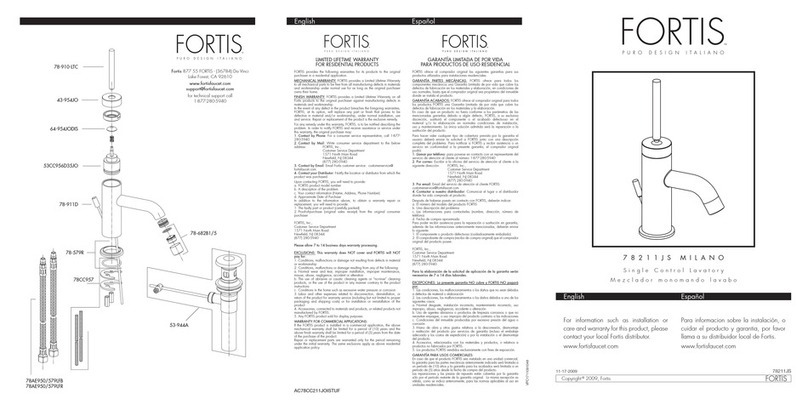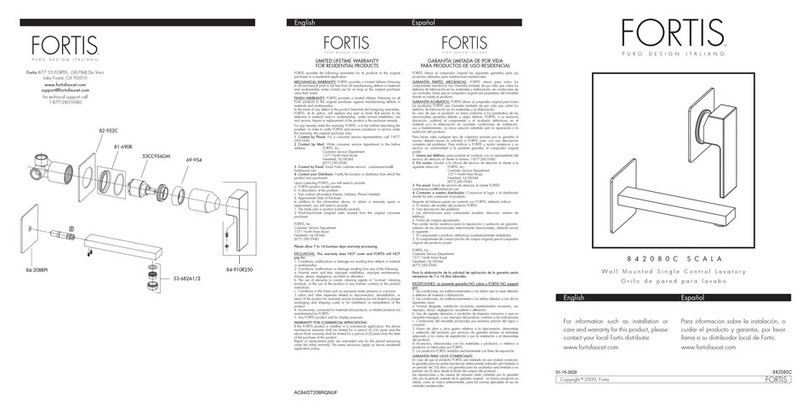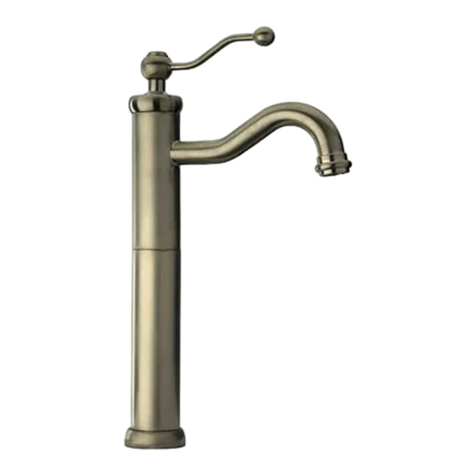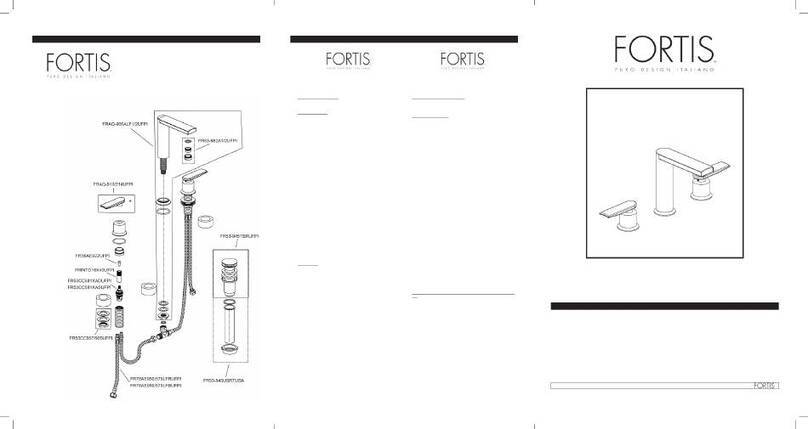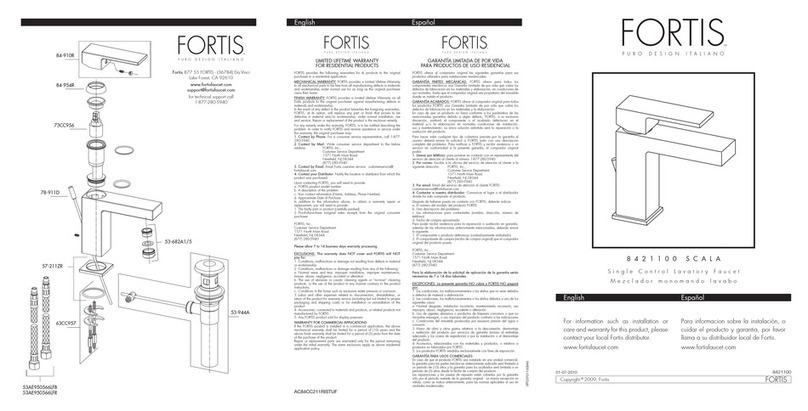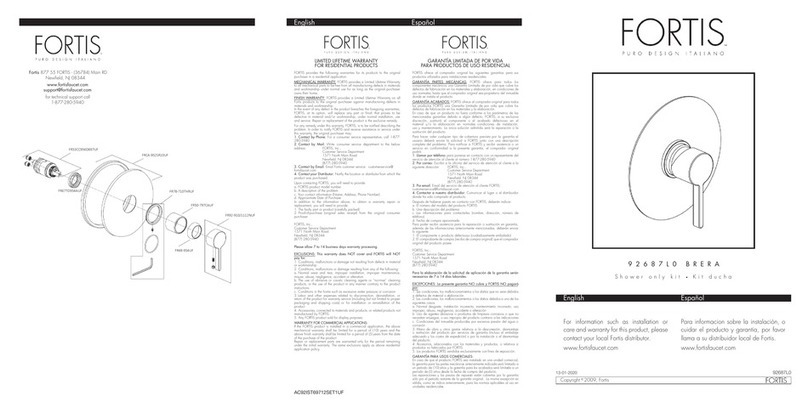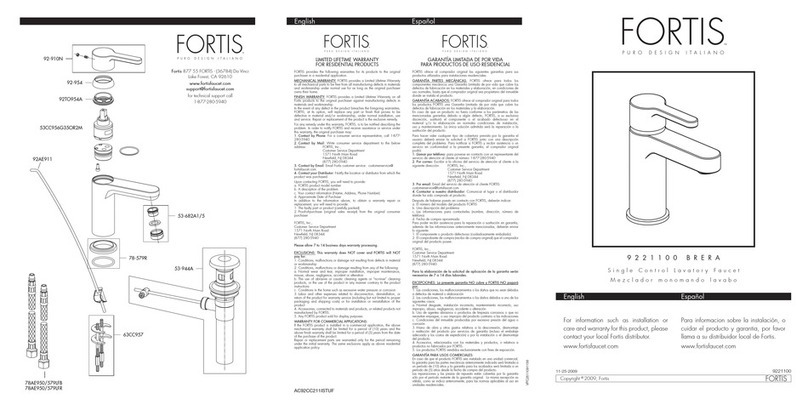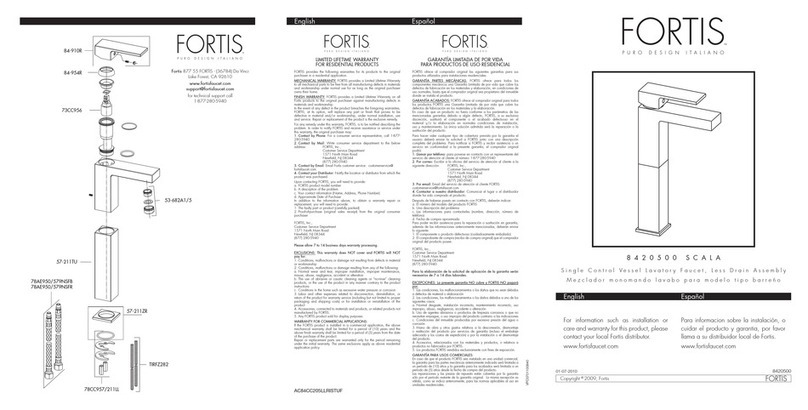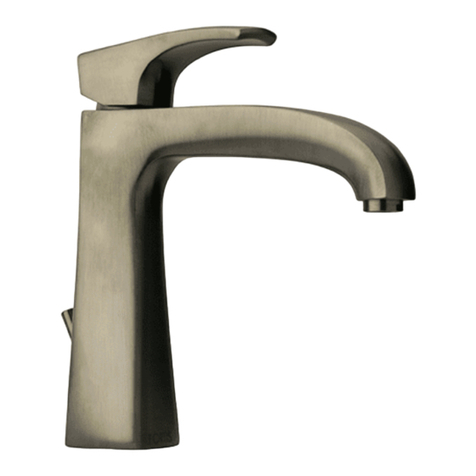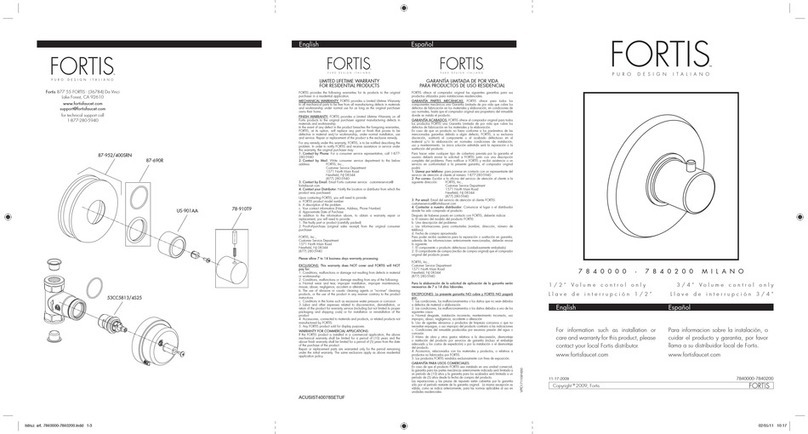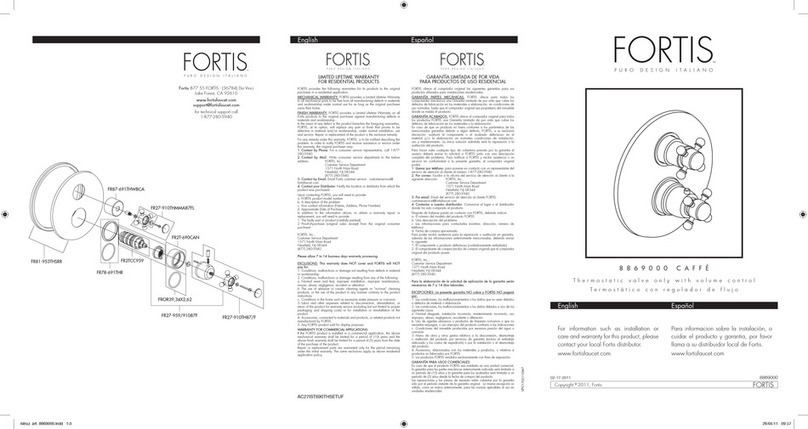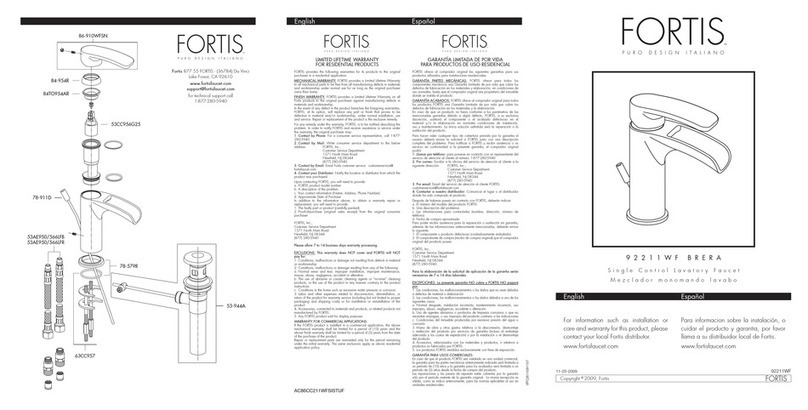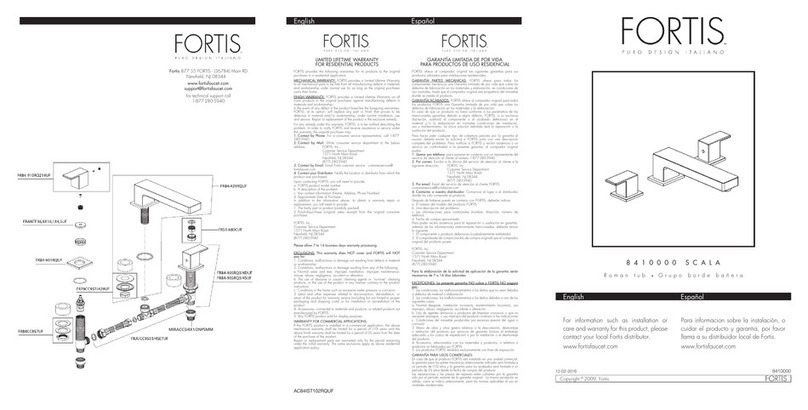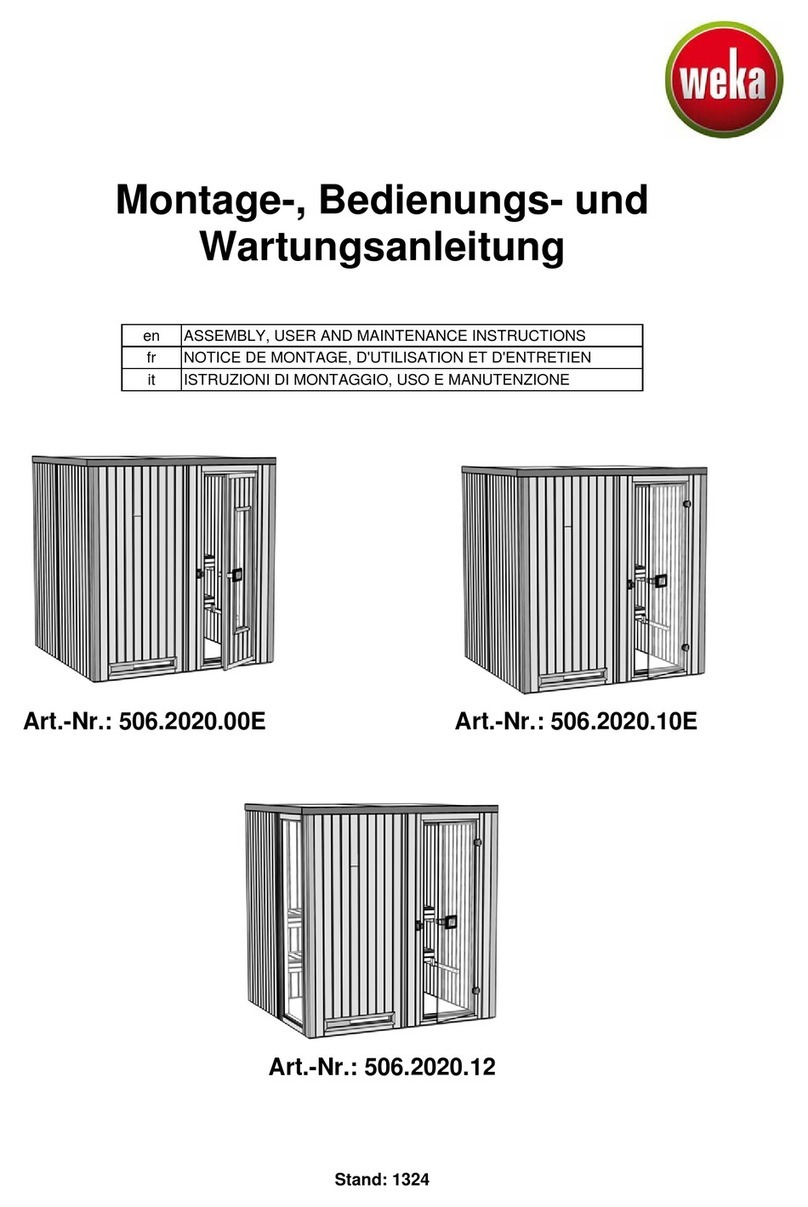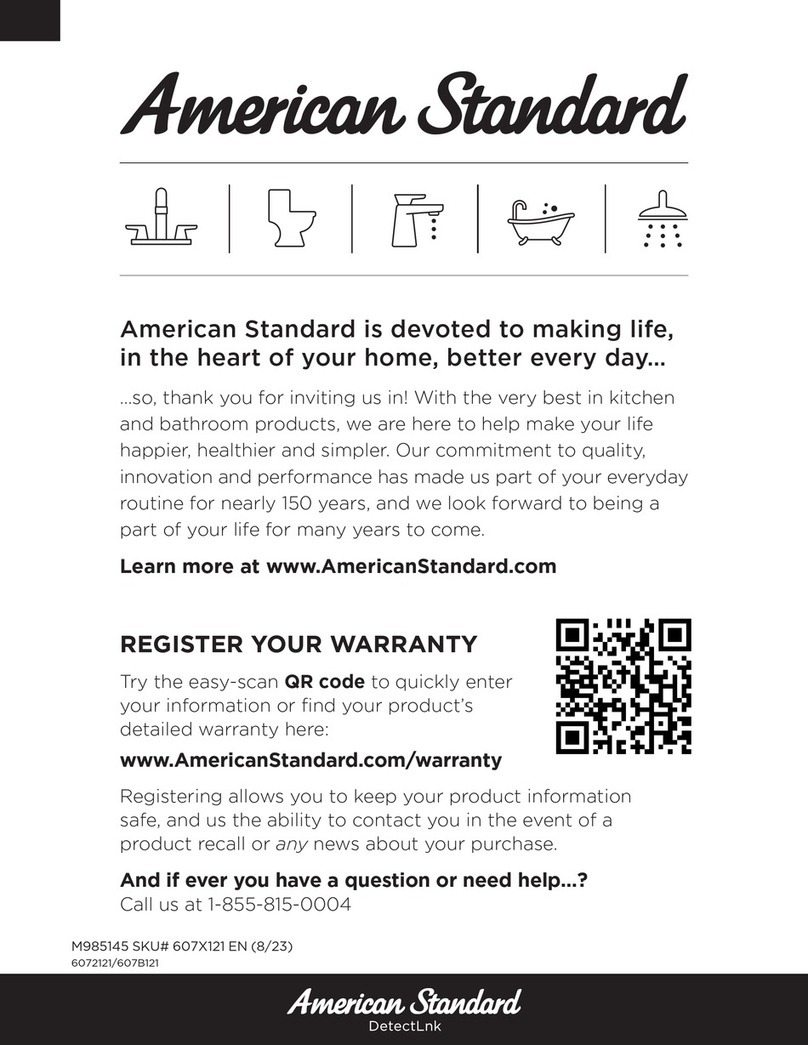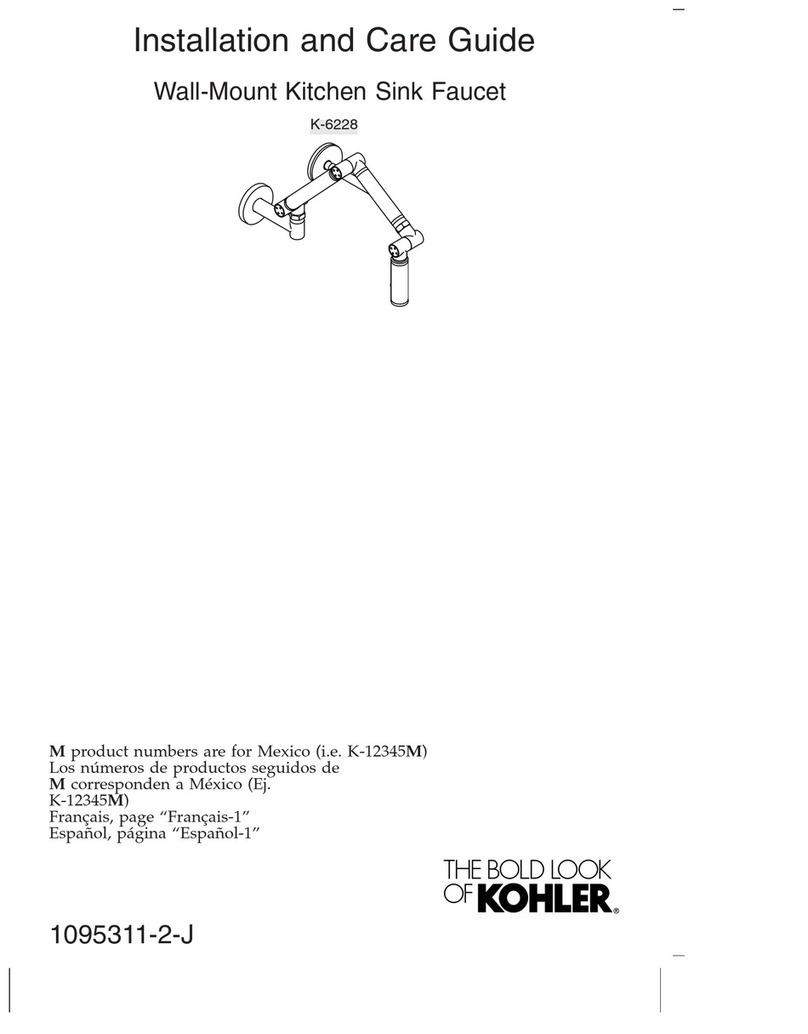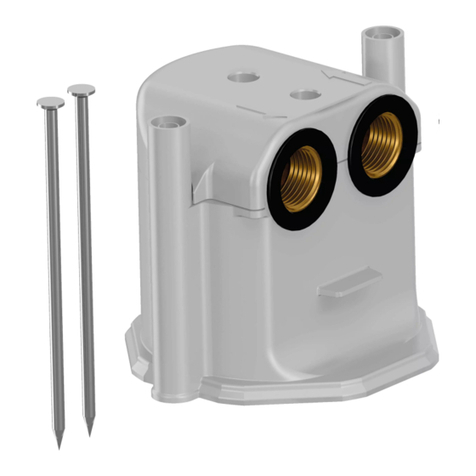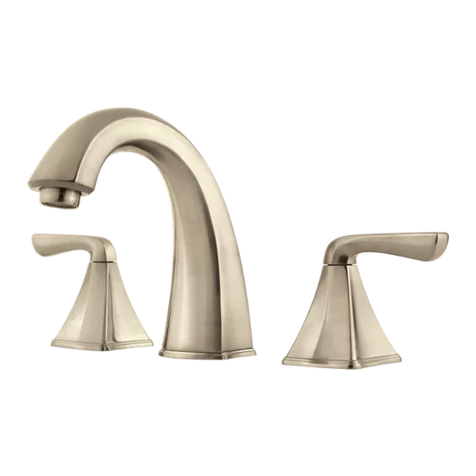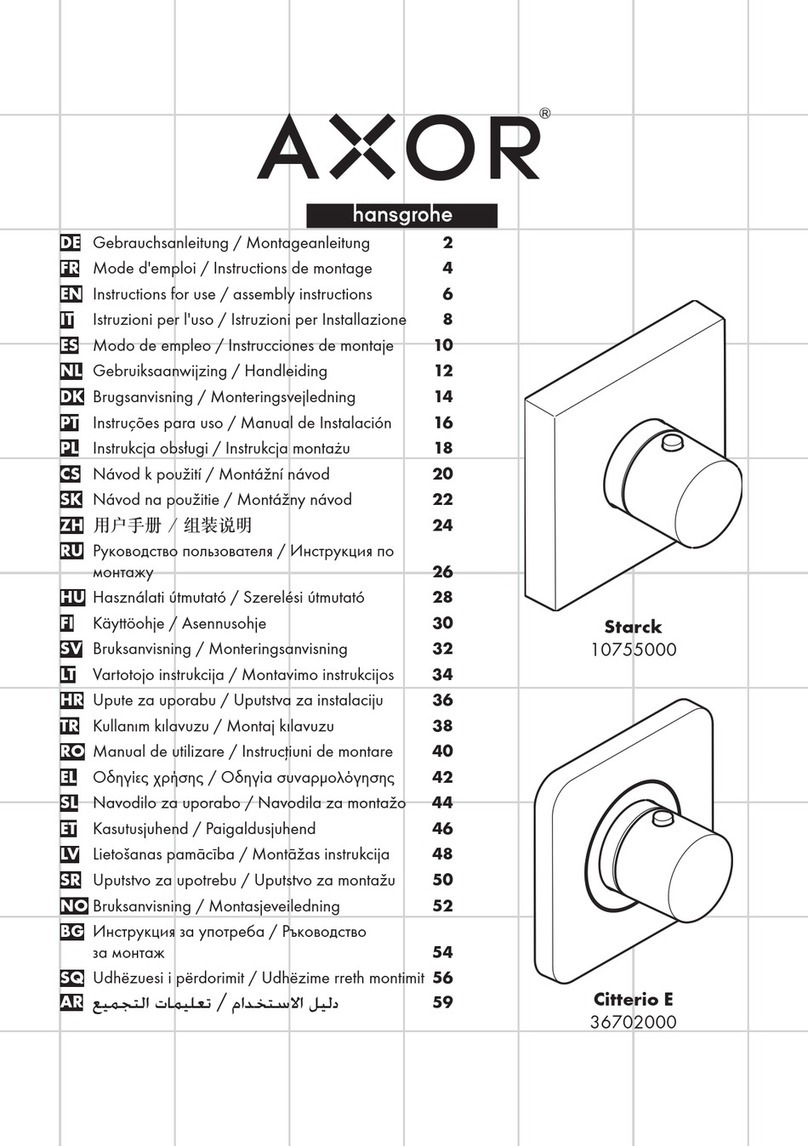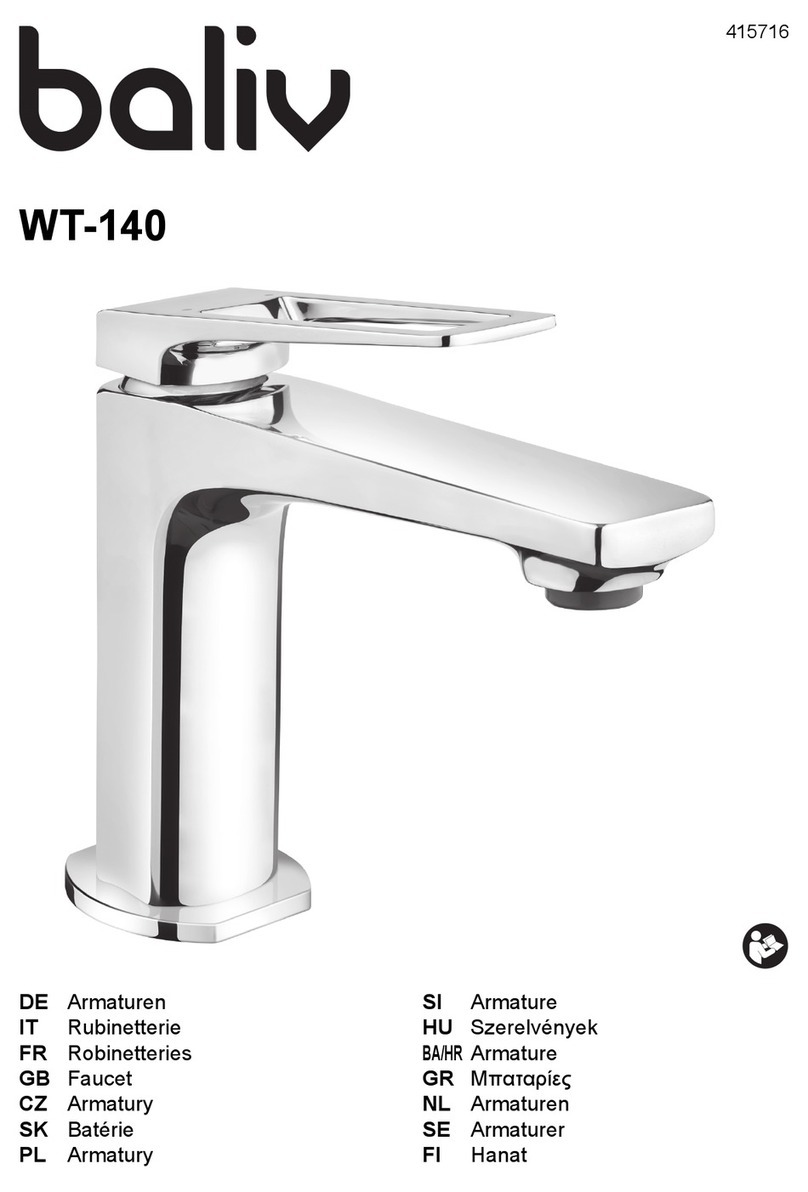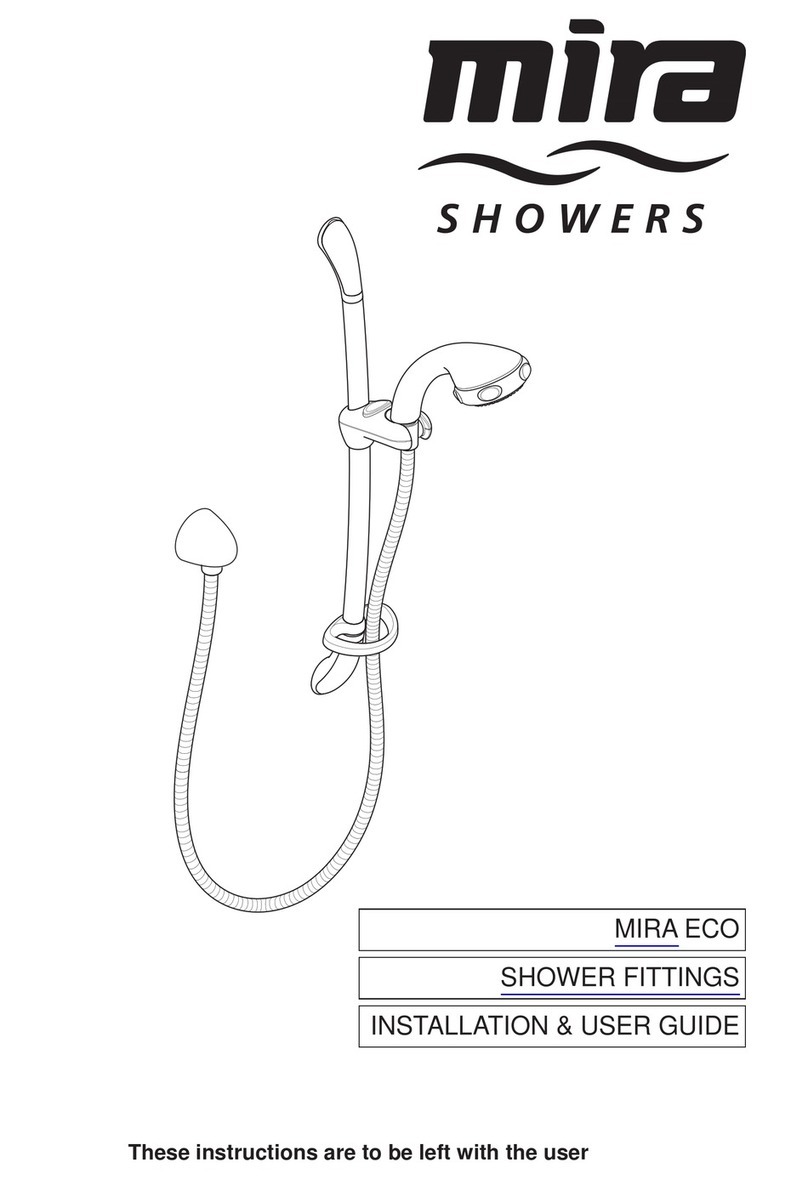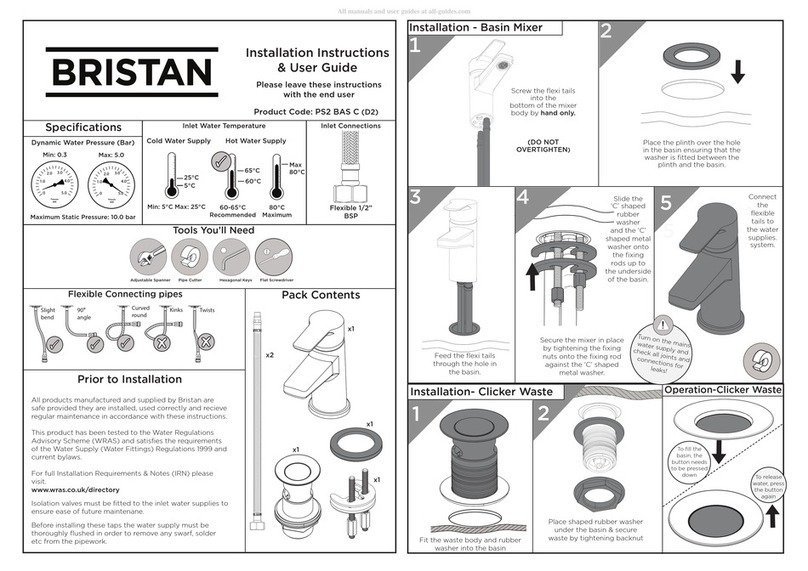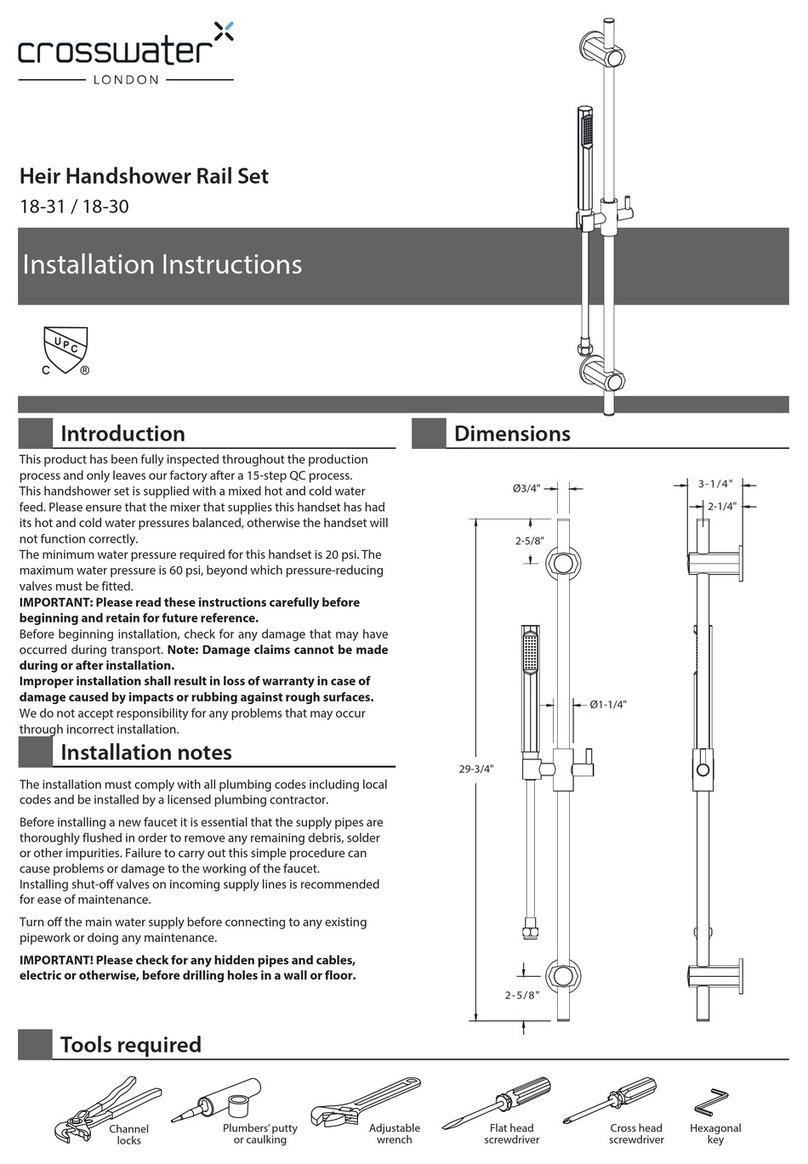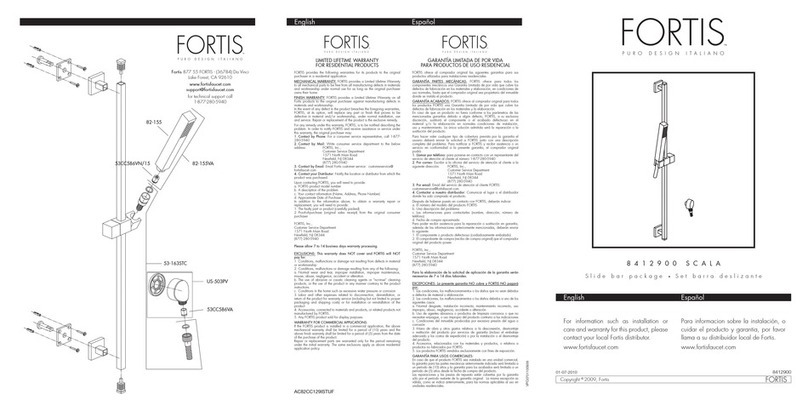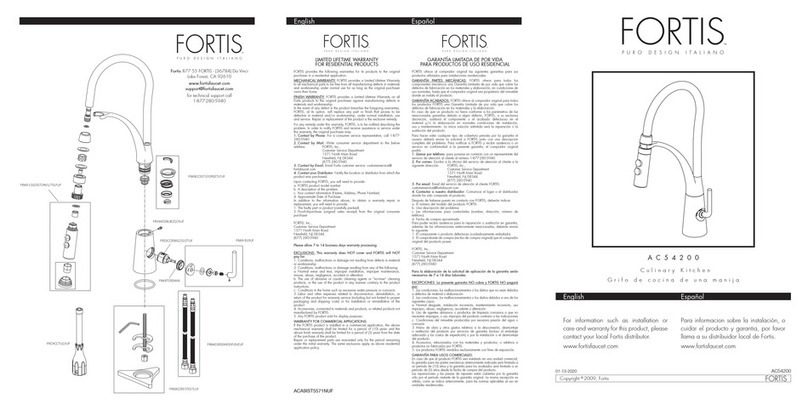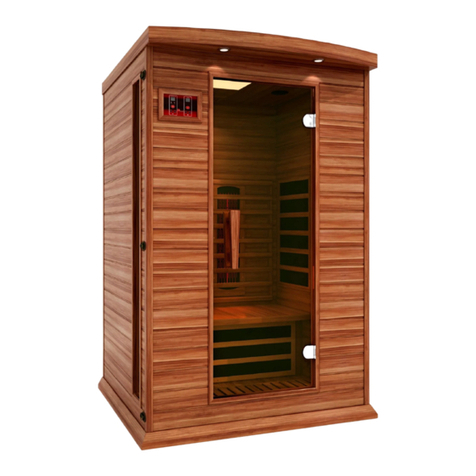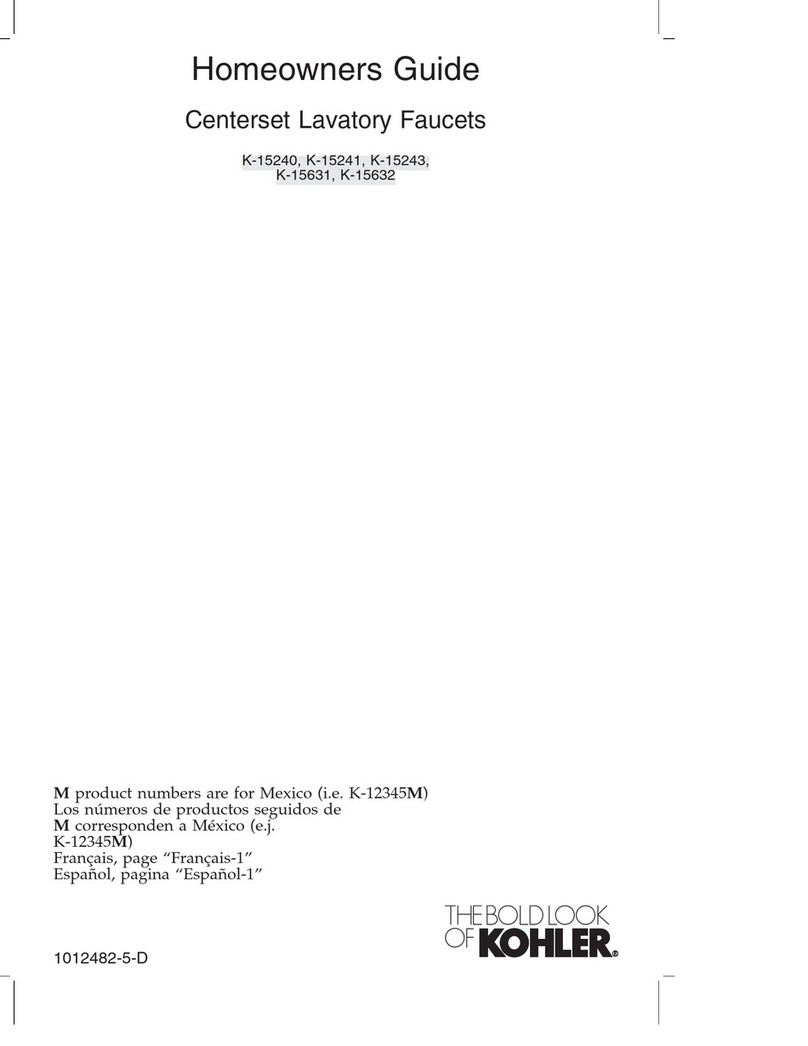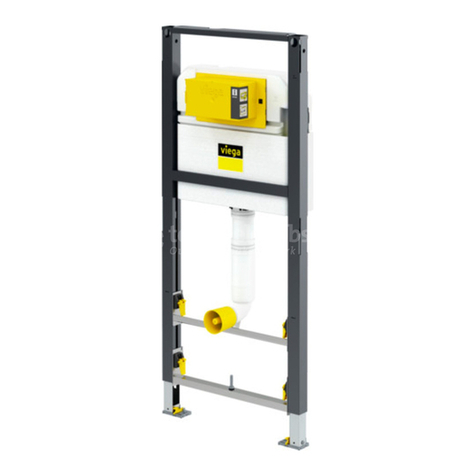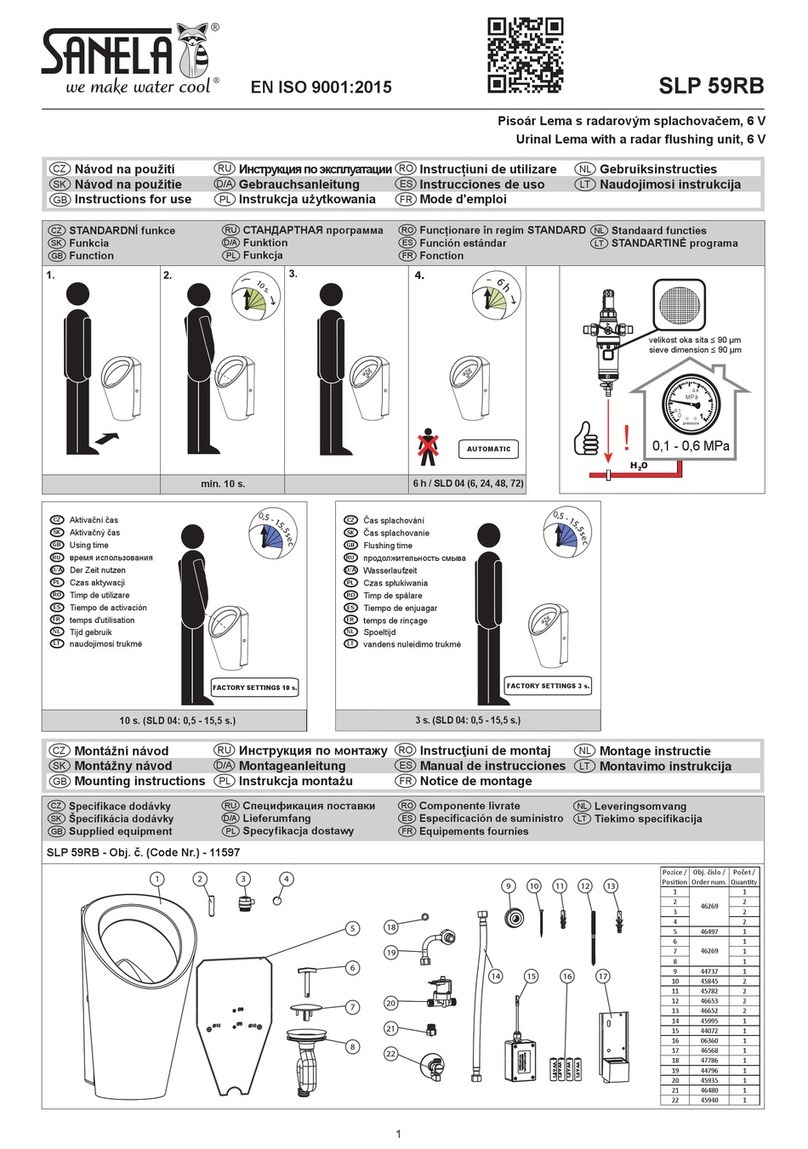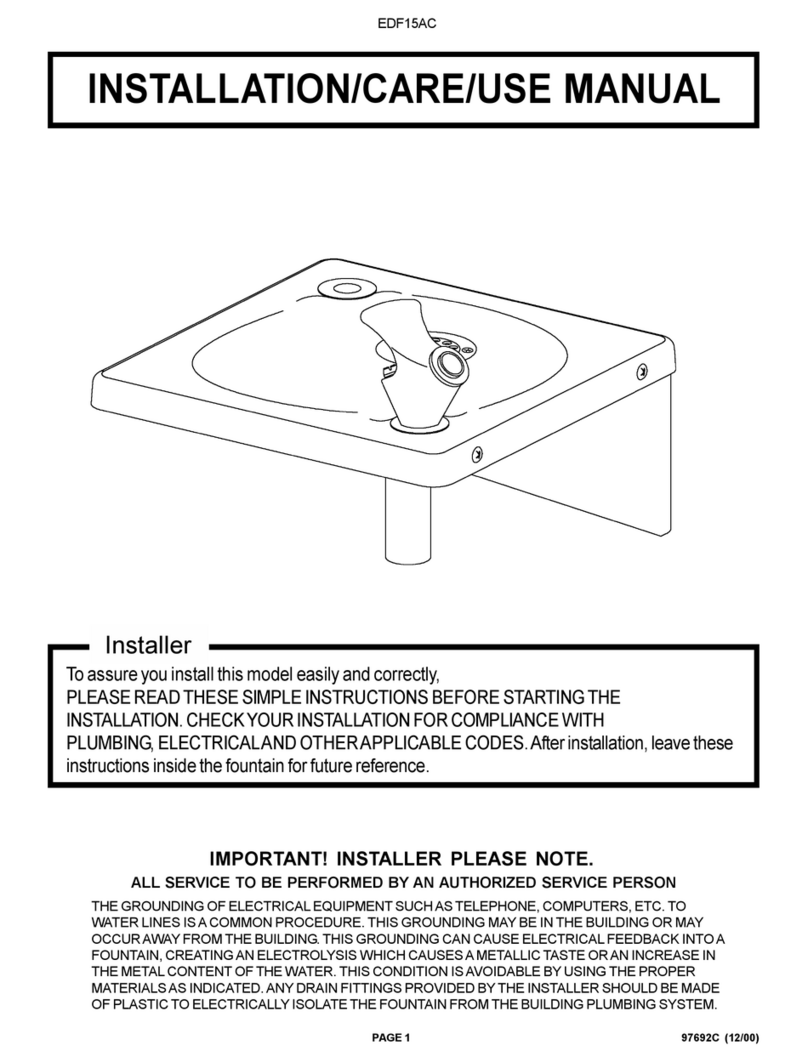
EspañolEnglish
En caso de presiones de funcionamiento
superiores a 5 bares (~75 PSI), se aconseja el
uso de un reductor de presión. Antes de efectuar
el montaje, se aconseja purgar las tuberías del
agua caliente y fría para evitar que suciedad y
pequeñas impurezas afecten el funcionamiento
del grifo.
INSTALACIÓN EMPOTRAMIENTO PRESSURE
BALANCE
FIG. 01
Acabar el revestimiento de la pared y retirar la
protección de plástico (2.A) mediante el uso de
un destornillador.
FIG. 02
Apretar en sentido horario las llaves (3.F) con un
destornillador; destornillar la virola (3.B) y extraer
el tapón (3.A). Poner el cartucho (3.C) dentro
del cuerpo empotrado, cerrar con la virola (3.B)
de manera que sea estanco y la manilla tenga
movimento suave.
Los grifos pressure balance tienen limitador de
températura para prevenir las quemaduras.
El límite establecido es 100°F max para
condiciones recomendadas (presión y températura
agua caliente/fria).
Si hay necesidad de cambiar el límite, girar la
virola (3.G): a la derecha para una températura
inferior, a la izquierda para una températura
superior.
Acabar con la tapa cromada (3.D) y atornillar por
fin el embellecedor (3.E)
FIG. 03
Retirar la cinta protectora de la esponja adhesiva
(3.G) y aplicarla en la parte posterior de la placa
(3.F). Montar la placa (3.F) en el cuerpo del grifo
y fijarla con la arandela (3.D) y la junta (3.E).
Montar la maneta (3.A), apretar atornillando el
tornillo prisionero (3.B) y atornillar la palanca
(3.C).
FIG. 04
Montar previamente el florón (4.E) en el brazo de
la ducha (4.D); atornillar este último en el racor
de pared. Apoyar el florón (4.E) a la pared, en
fin, montar el rociador (4.A) en el brazo (4.D)
interponiendo la junta (4.C) y prestando atención
a que la válvula antirretroceso (4.B) esté montada
correctamente.
FIG. 05
En caso de que fuera necesario sustituir el
cartucho, destornillar la palanca (5.C), destornillar
el tornillo prisionero de fijación (5.B) y extraer
la maneta (5.A). Extraer la arandela (5.D) que
incluye la junta y retirar la placa (5.E). Con un
destornillador cerrar las válvulas de retención (5.I)
con una simple rotación de 90°. Destornillar el
capuchón (5.F), la abrazadera (5.G) y retirar el
cartucho (5.H). Montar nuevamente efectuando
las operaciones en sentido inverso. Los grifos
pressure balance están dotados de limitador
de temperatura para prevenir las quemaduras.
La limitación configurada es 100 °F máx. para
condiciones de instalación recomendadas
(presiones y temperatura agua caliente/fría).
Si es necesario variar la limitación, girar la
específica abrazadera (5.L) indicada en la figura:
en sentido horario para obtener una temperatura
de erogación más baja, en sentido antihorario
para una temperatura más alta.
FIG. 06
Levantar la palanca (12A) para activar la
válvula que permite el flujo del agua. Continuar
levantando la palanca (12A) para aumentar el
caudal. Girar la palanca en sentido antihorario
para activar sólo el flujo de agua fría. Girar la
palanca en sentido horario para activar sólo el
flujo de agua caliente.
MANTENIMIENTO DE LAS SUPERFICIES
Durante la limpieza la superficie del grifo debe estar
fría (el calor acelera el desgaste de la superficie
misma). Asegurarse de que los productos para
la limpieza no contengan ácidos o sustancias
corrosivas. El grifo debe ser secado diariamente
con un paño suave. Evitar absolutamente esponjas
de acero, esponjas abrasivas u otros productos
similares. Inmediatamente después de la limpieza,
enjuagar bien los residuos de detergente con
agua fría. Los daños a los grifos debidos a un
tratamiento no adecuado no están cubiertos por
la garantía.
Water Supply Recommended Maximum Minimum
Hot Water Temperature 65 C° (~150F) 80 C° (~175F) 15 C° (~60F)
Working Pressure 3 BAR (~45PSI) 5 BAR (~75PSI) 0.5 BAR (~7PSI)
Alimentación Recomendada Máxima Mínima
Temperatura agua
caliente
65 C° (~150F) 80 C° (~175F) 15 C° (~60F)
Presión de
funcionamiento
3 BARES (~45PSI) 5 BARES (~75PSI) 0.5 BARES (~7PSI)
INSTALLATION INSTRUCTIONS INSTRUCCIONES DE INSTALACIÓN
Based on its policy of steady development Fortis reserves the right to change the characteristics
of the products without notice and therefore the images and data contained in this catalogue may vary.
Por su política de continuo desarrollo, Fortis se reserva el derecho de modificar las características de los productos sin ningún aviso
previo; por tanto, las imágenes y los datos contenidos en el presente catálogo deben considerarse a título indicativo.
FIG. 01
FIG. 02
FIG. 03 FIG. 04
FIG. 06
FIG. 05
In case of pressures over 5 BAR (~75 PSI), we
recommend to use a pressure reducer.
Before proceeding with the assembly, purge
the hot and cold water pipes so as to avoid the
accumulation of dirt and impurities that could
affect the function of the tap.
PRESSURE BALANCE BUILT-IN INSTALLATION
FIG. 01
Finish the wall and remove the plastic cover (2.A)
using a screwdriver.
FIG. 02
Screw the stop valves (3.F) with a screwer,
unscrew the nut (3.B) and remove the cover (3.A).
Insert the cartridge (3.C) into the built-in body,
and screw with the nut (3.B) assuring tight and
allowing an easy handling of the lever. Pressure
balance faucets are provided with temperature
restrictor to avoid burns. Restriction is calibrated at
100 °F max for recommended conditions (working
pressure and hot/cold water temperature).
If necessary to change temperature restriction turn
the ring (3.G) as indicated in the figure: rigth to
get a lower supply temperature, left for a higher
supply temperature. Position the finish cap (3.D)
and screw the cover (3.E).
FIG. 03
Remove the protection tape of the adhesive
sponge (3.G) and apply it on the back of the
plate (3.F). Fit the plate (3.F) on the tap body and
lock it using the washer (3.D) and the gasket (3.E).
Assemble the handle (3.A), tighten the grub screw
(3.C) and install the decoration cap (3.B).
FIG. 04
Pre-assemble the rosette (4.E) on the shower arm
(4.D); screw the shower arm on the wall joint. Fit
the rosette (4.E) so that it is flush to the wall and
install the shower head (4.A) on the arm (4.D)
positioning the gasket (4.C) in between. Make
sure the check valve (4.B) is correctly installed.
FIG. 05
To replace the cartridge, pull out the decoration
cap (5.B), loosen the grub screw (5.C) and
remove the handle (5.A). Slide off the flat washer
(5.D) with the gasket and pull off the plate (5.E).
With a screwdriver rotate the stop valves (5.I) by
90° to close them.
Screw off the protection cylinder (5.F) and the lock
nut (5.G) and remove the cartridge (5.H).
Reassemble in reverse order. Pressure balance taps
are equipped with an anti-scalding temperature
limiting device. The tap is pre-set at 100 °F
max for recommended system conditions (hot/
cold water pressure and temperature). To adjust
the temperature, rotate the lock nut (5.L) shown:
clockwise to decrease the water temperature,
counter-clockwise to increase it.
FIG. 06
Pull the lever (6A) upwards to activate the valve
and start the water flow. Repeatedly pulling the
lever (6A) will increase the water flow. Rotate the
lever counter-clockwise to decrease the water
temperature to cold flow only. Rotate the lever
clockwise to increase the water temperature to hot
flow only.
MAINTENANCE OF THE SURFACES
Before cleaning, make sure the tap is cold (heat
wears the surface of the tap down). Do not use
products containing acids or corrosive substances.
Wipe the tap daily with a soft cloth. Do not use
steel wool or metal pads, abrasive sponges or
similar products. Right after cleaning rinse off the
detergent residues with cold water. Damages to
the taps caused by incorrect treatment are not
covered by the warranty.
Istruz. art. 7869700.indd 4-6 06/06/11 08:37


